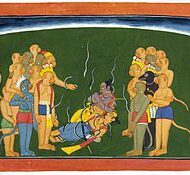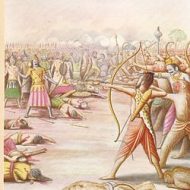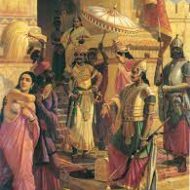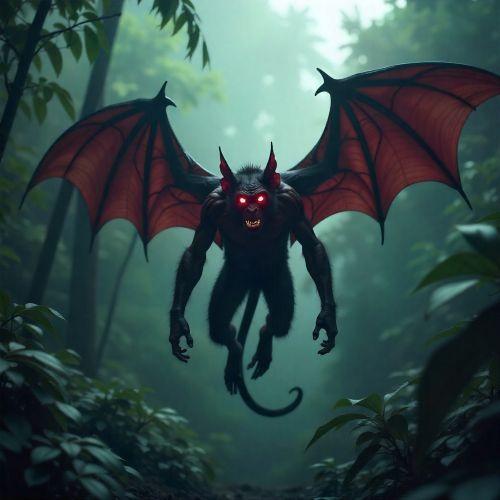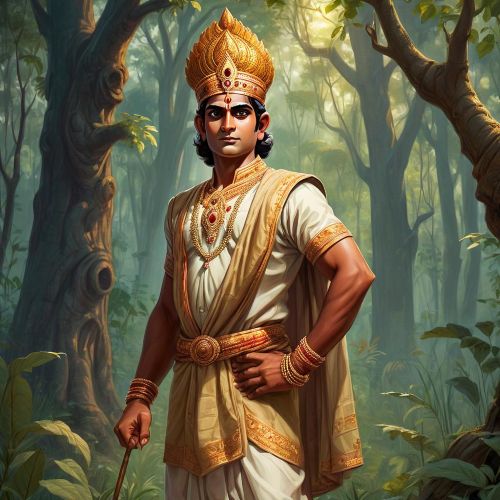Indrajit : The Warrior Prince Who Defied the Gods
Listen
At a glance
| Description | |
|---|---|
| Origin | Indian Mythology |
| Classification | Mortals |
| Family Members | Ravana (Father), Mandodari (Mother), Akshaya Kumara (Brother) |
| Region | India, Sri Lanka |
| Associated With | War, Weapons, Magic, Sorcery |
Indrajit or Meghnad
Introduction
Among the formidable figures of the Ramayana, few command as much awe and complexity as Indrajit, the warrior prince of Lanka and son of the demon king Ravana. Known for his unmatched skill in warfare and mastery over divine weapons, Indrajit stands as one of mythology’s greatest antagonists — not defined merely by evil, but by brilliance, discipline, and valor.
Originally named Meghanada, meaning “the thunderous one,” he earned the title Indrajit — “the conqueror of Indra” — after defeating the king of the gods in battle. His story is one of paradoxes: a demon born into darkness yet disciplined in sacred knowledge; a warrior destined for greatness yet bound by pride and fate.
Through his tale, the Ramayana reminds readers that even those aligned with the forces of chaos can embody extraordinary devotion, skill, and complexity — virtues that make Indrajit one of the epic’s most tragic heroes.
Physical Traits
Indrajit is described in classical texts as a radiant and fearsome warrior, his body glowing with an inner fire inherited from his father Ravana’s divine lineage. His eyes blaze red like molten metal, and his presence inspires awe and dread alike. He wears dark armor inlaid with gold, symbolizing his command over both power and illusion.
Artists often depict him wielding celestial bows and arrows, standing astride a chariot drawn by mythical beasts. Some renderings portray him with multiple arms during battle, each carrying a divine weapon granted by the gods. His name Meghanada — “one who roars like thunder” — suggests not only his physical might but also the storm-like ferocity that followed him in combat.
As with many rakshasas, his form reflects both divinity and shadow — a being of immense spiritual potential who chose the path of destruction.
Family
Indrajit was born to Ravana, the ten-headed king of Lanka, and Mandodari, one of the most intelligent and virtuous women in myth. Despite being the son of a demon, Indrajit was raised in an environment of learning and discipline. Mandodari’s influence imbued him with respect for dharma and knowledge, while Ravana’s tutelage trained him in Vedic warfare, mantras, and the use of celestial weapons.
He married Sulochana, a noble and virtuous woman known for her wisdom and loyalty. Their union symbolizes the duality of Indrajit’s life — a man of love and devotion who nevertheless fought on the side of darkness. His loyalty to his father and his kingdom, even in the face of inevitable defeat, marks him as a figure of tragic nobility.
Other Names
Indrajit’s birth name was Meghanada, a title reflecting his thunderous battle prowess. After his victory over Indra, the ruler of the heavens, he was renamed Indrajit — “the conqueror of Indra.”
In some regional texts, he is also referred to as Ravana Kumara (“the son of Ravana”) or Mahaveer Meghanada (“the great hero Meghanada”). In Jain and Buddhist retellings, Indrajit appears as a valorous yet doomed prince who embodies the impermanence of pride and power. While his name may vary, his legacy remains consistent: a warrior whose devotion to duty elevated him even among his divine adversaries.
Powers and Abilities
Indrajit’s strength was unparalleled. Trained in both warfare and mystical arts, he mastered the use of celestial weapons (astras) that few mortals could control. He was the only warrior apart from the gods who could invoke the Brahmastra, Vajra, and Pashupatastra — weapons of cosmic destruction.
His greatest power, however, was his ability to become invisible in battle. Through his mastery of the tantric yagna rituals taught by Ravana and Shiva, he could vanish from sight, striking enemies unseen — a terrifying advantage that made him nearly invincible.
He was also a skilled sorcerer who could create illusions, summon divine beings, and manipulate the battlefield with supernatural precision. His victories over Indra, Rama’s forces, and even Hanuman at various stages demonstrate both his might and intellect.
Yet his strength was not limitless. According to prophecy, Indrajit’s invulnerability depended on performing a sacred fire ritual before battle. When Lakshmana disrupted this ceremony, Indrajit’s fate was sealed — a reminder that even the greatest power collapses when faith turns into arrogance.
Modern Day Influence
In modern Hindu thought, Indrajit occupies a complex space — revered for his heroism yet remembered for his tragic allegiance. He represents the paradox of a brilliant soul misaligned with righteousness: disciplined but misguided, powerful yet prideful.
Artists and writers across India and Southeast Asia have reimagined his story as one of duty over desire, where loyalty to family outweighs personal salvation. In Sri Lanka, Indrajit is often portrayed as a national hero — a symbol of courage and patriotism defending his homeland against invaders.
In popular culture, Indrajit appears in television adaptations like Ramayana (1987, 2008, and 2020) and modern graphic novels such as Ravanaayan and The Legends of Indrajit. These depictions highlight his complexity, transforming him from a villain into a tragic anti-hero torn between fate and faith.
Philosophically, Indrajit’s story invites reflection on karma and choice. He is a reminder that even divine strength must bow before the moral order of the universe — that victory without virtue is only illusion. Today, Indrajit continues to inspire readers and artists as one of mythology’s most nuanced figures — a warrior of darkness whose brilliance illuminated the meaning of dharma through contrast.
Related Images
Source
Goldman, R. P. (1984). The Ramayana of Valmiki: An Epic of Ancient India. Princeton University Press.
Kamban, T. (2002). Kamba Ramayanam (Tamil Edition). Bharatiya Kala Prakashan.
Doniger, W. (2009). The Hindus: An Alternative History. Penguin Press.
Klostermaier, K. K. (2007). A Survey of Hinduism. State University of New York Press.
AncientOrigins. (2022). Indrajit: The Invincible Warrior Prince of Lanka. https://www.ancient-origins.net/myths-legends-asia/indrajit-prince-lanka-0017669
LearnReligions. (2023). Indrajit – The Conqueror of Indra in Hindu Mythology. https://www.learnreligions.com/indrajit-hindu-mythology-5076033
IndiaNetzone. (2021). Indrajit: The Mighty Son of Ravana. https://www.indianetzone.com/42/indrajit.htm
Wikipedia contributors. (n.d.). Indrajit. In Wikipedia, The Free Encyclopedia. https://en.wikipedia.org/wiki/Indrajit
Frequently Asked Questions
How was Indrajit killed in Ramayana?
Lakshmana disrupted Indrajit’s ritual of worshipping Nikumbila before stepping into battle. Indrajit unleased his divine arrows which refused to harm Lakshmana who was protected by Shesha. Lakshmana finally killed Indrajit with the Aindastra.
Who was Indrajit's wife?
Indrajit was married to Sulochana who was the daughter of Sheshnaga, the king of the Nagas.
Who was more powerful Ravana or Indrajit?
Although an accomplished warrior in every aspect, it is widely believed that Indrajit was the greatest warrior in the Ramayana because of his mastery over illusionism and sorcery along with skills in warfare.
What is the story behind Meghnad's birth?
Meghanada was given his name due to the sound of his cries at birth, which were said to resemble thunder. His father, Ravana, was a renowned astrologer who wished for his son to be supreme and unbeatable in battle. In order to ensure Meghanada’s immortality, Ravana commanded all the planets and constellations to align in a specific way at the time of his son’s birth. However, Saturn (Shani) defied Ravana’s orders and took its place in the 12th house of Meghanada’s horoscope, causing Ravana to become enraged.
Who gave Indrajit his name?
The title Indrajit was given by Lord Brahma to Meghanad after he defeated Lord Indra in battle.


